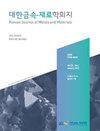A Study on the History of Advances in Ancient Iron Making Based on Correlation of Oxides in Slag
IF 1.4
4区 材料科学
Q4 MATERIALS SCIENCE, MULTIDISCIPLINARY
引用次数: 1
Abstract
A lot of slag was produced by ancient production processes such as smelting, melting, and refining. Iron slag has information that can be used to determine the characteristics of the site, the iron-making process and manufacturing date, but there is a limit to reading information through visual observation and nondestructive analysis. Various slag terms have been used depending on the location and characteristics, but it is necessary to use terms that have exact meaning and unity. Although many scientific analyses have been supplemented by archaeological theses, the iron-making trends of each period have not yet been systematically proven. This study reviewed the type of iron-making process used for 100 ancient slags. The slags were analyzed by XRF, revealing when it was formed and some of the detailed processes. XRD analysis was used to define and classify Tap slag, Bloom slag, and Ceramic-rich slag as relative concepts. From the Three Kingdoms Period to the Joseon Dynasty, the amount of temperature variation in the iron-making furnace decreased and the GAS reaction became uniform. It was observed that the amount of iron oxide remaining decreased and the proportion of ceramic-rich slag increased. The change in iron oxide content kept decreasing while the levels of refining, smelting, and melting were maintained, in that order. The results confirmed that advances in ancient iron-making technology can be interpreted based on a comparative review of the relative changes in iron oxide and silicon oxide content in slag.基于炉渣中氧化物相关性的古代炼铁发展史研究
许多炉渣是通过冶炼、熔炼和精炼等古老的生产工艺产生的。铁渣具有信息,可用于确定场地特征、炼铁工艺和制造日期,但通过目测和无损分析读取信息是有限制的。根据不同的地点和特点,已经使用了各种各样的炉渣术语,但必须使用具有确切含义和统一的术语。尽管考古论文补充了许多科学分析,但每个时期的炼铁趋势尚未得到系统的证实。本文综述了100种古代炉渣的炼铁工艺类型。用XRF对渣进行了分析,揭示了渣的形成时间和一些详细的过程。采用XRD分析对Tap渣、Bloom渣和富瓷渣进行了相关概念的定义和分类。从三国时期到朝鲜时期,炼铁炉内的温度变化量减少,气体反应趋于均匀。实验结果表明,渣中氧化铁残留量减少,富陶渣比例增加。在精炼、熔炼和熔炼的水平保持不变的同时,氧化铁含量的变化不断减小。结果证实,古代炼铁技术的进步可以通过对炉渣中氧化铁和氧化硅含量的相对变化进行比较来解释。
本文章由计算机程序翻译,如有差异,请以英文原文为准。
求助全文
约1分钟内获得全文
求助全文
来源期刊

Korean Journal of Metals and Materials
MATERIALS SCIENCE, MULTIDISCIPLINARY-METALLURGY & METALLURGICAL ENGINEERING
CiteScore
1.80
自引率
58.30%
发文量
100
审稿时长
4-8 weeks
期刊介绍:
The Korean Journal of Metals and Materials is a representative Korean-language journal of the Korean Institute of Metals and Materials (KIM); it publishes domestic and foreign academic papers related to metals and materials, in abroad range of fields from metals and materials to nano-materials, biomaterials, functional materials, energy materials, and new materials, and its official ISO designation is Korean J. Met. Mater.
 求助内容:
求助内容: 应助结果提醒方式:
应助结果提醒方式:


